Gibco Human bFGF Recombinant Protein

- 品名: Gibco Human bFGF Recombinant Protein
- 品牌: 赛默飞世尔
- 型号: 暂无
- 产品详情
- 规格参数
产品细节

产品详细信息
•Purity: ≥95% by SDS-Page
•Endotoxin Concentration: ≤0.1 ng/µg
•Biological Activity: ED50 ≤1.0 ng/mL
•Carrier-Free
Reconstitution: Reconstitute in 100 µL of 10 mM Tris, pH 7.6, to yield a stock solution of 0.1 mg/mL of bFGF. To avoid loss due to adsorption, prepare dilute solutions in appropriate assay buffer containing at least 0.1% BSA just prior to use. Do not store in dilute solution. For longer term storage, aliquot into buffer containing 0.1% BSA and store in polypropylene vials at -20°C. Avoid repeated freezing and thawing. In applications requiring long-term use of this growth factor in cell cultures, refilter material after dilution in BSA-containing buffer, through a 0.22 micron low protein-binding filter
Storage: Six months at -20°C as received. Up to six months at -20°C when aliquoted into solution containing carrier protein (see Reconstitution Recommendation). NOTE: Do not store in dilute aqueous solution. Avoid repeated freeze/thaw.
靶标信息
FGF2 (FGFb, fibroblast growth factor basic) belongs to the fibroblast growth factor (FGF) family, and interacts with high-affinity transmembrane receptors to influence cell proliferation and tissue neovascularization. FGF2 exists as five isoforms with distinct intracellular localizations and functions. The 18 kDa isoform is predominantly cytosolic and acts through cell surface receptors, whereas the 22, 22.5, 24 and 34 kDa isoforms are nuclear and may signal independent of transmembrane receptor pathways. In humans, the gene is located on the q arm of chromosome 4. FGF2 has been implicated in diverse biological processes, such as limb and nervous system development, wound healing, and tumor growth. The mRNA for FGF2 contains multiple polyadenylation sites, and is alternatively translated from non-AUG and AUG initiation codons, resulting in five different isoforms with distinct properties. The CUG-initiated isoforms are localized in the nucleus and are responsible for the intracrine effect, whereas, the AUG-initiated form is mostly cytosolic and is responsible for the paracrine and autocrine effects of this FGF. Diseases associated with FGF2 dysfunction include Kaposi Sarcoma and corneal neovascularization.



